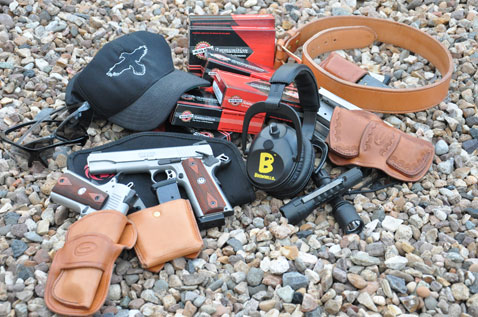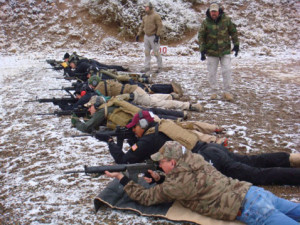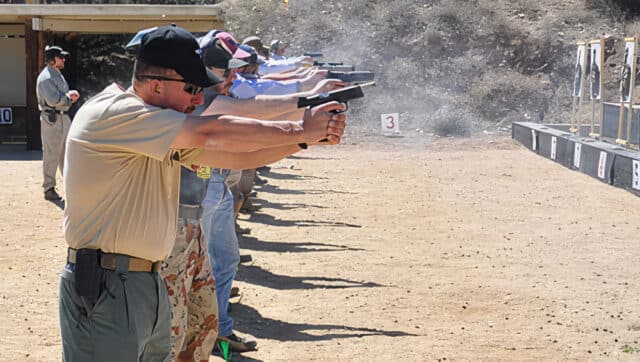Congratulations on making the decision to attend a shooting school. You’re going to have a great time expanding your education and skill level and it just might be a life changing experience. To get the most out of your training you’re going to want to put some thought into preparing yourself, your guns and your gear. Here are some of the things I think will help make the most of your investment in time and money.
Guns
Whether a pistol, rifle or shotgun class you’re going to want to make sure your guns are up to the task. If in doubt, check with the school you will be attending to see what they recommend. I usually suggest you shoot what you normally carry but there are some exceptions. While a police officer should use his duty gear a CCW pocket pistol isn’t going to be appropriate in a tactical pistol class. Make sure your guns are reliable, as fighting one that continually malfunctions is no fun. Having a spare pistol similar to the one you plan on using is a good idea; some schools have gunsmiths and loaner guns on site, while others don’t offer this level of support. While bringing a spare may be a good idea, planning on shooting several different guns during the course isn’t. Pick one and stick with it to get the most from your training. Even though you may not have noticed any sharp edges on your firearms before, if they’re present you will discover them during your class. Having sore, cut up hands is no fun and will seriously detract from your ability to learn, so get those sharp edges smoothed out should you find any that are giving you trouble.
Ammo
A class can consume anywhere from a few hundred to several thousand rounds of ammunition. In some cases the cost of the ammo may exceed the tuition. Some schools can provide ammunition, usually at competitive prices, so buying the ammo from them will save you the cost and hassle involved in shipping or transporting your ammunition to the training site. Another option is to shop the ‘net for a good deal and have the ammunition drop shipped to the school. In most cases you will want to avoid shooting defensive ammunition like premium hollow points in class due to the increased cost. On the other hand, it is usually a bad idea to try to save money by shooting cheap, surplus ammo of questionable quality. If you reload your own ammunition there’s nothing wrong with using your reloads – I’ve seen them work well in class and I’ve seen some real problems with poor quality reloads. Generally speaking it’s better to spend a little extra money on good ammunition than risk having your training experience diminished due to poor ammo.

Support Gear
Holsters, belts, spare magazines, mag pouches and slings (for long arm classes) are all part of the gear you’re going to need in class. We carry handguns in the holster and hang rifles and shotguns from a sling so most classes will have you working from a holster or sling position. Some schools may prohibit certain carry positions (shoulder holsters or cross draw) and there may be other restrictions on gear so check with the school to see what they recommend. If the school has a pro shop you can select from gear they stock for their training but, again, checking ahead is a good idea as they may not carry holsters for non-standard pistols like your custom Blaster 5000 and will have to order it for you ahead of your class date. You’ll likely need six or more spare magazines (or speed loaders or clips) and pouches to carry them. By the time you get spare magazines, a holster and a pistol on a belt it needs to be a sturdy one that will support your gear without sagging or allowing it to flop around. For some classes elbow and kneepads may be recommended and you will need a quality tactical flashlight if the class includes low light training. Protective eyewear, both clear and tinted, is a must along with a brimmed hat or ball cap. Hearing protection ranges from simple earplugs to ear muffs and amplified electronic “ears”. I strongly recommend you consider investing in a set of electronic earmuffs, as they will protect your hearing while allowing you to have a better training experience because you can more easily hear and understand range commands.
Clothing
 You’ll need comfortable outdoors clothing suited to the climate. I’ve seen women who showed up for training in skirts and heels and men in business slacks and tassel loafers and neither is suitable for a week of outdoors physical activity. You’re going to be on your feet for hours each day; investing in a pair of comfortable boots or shoes will greatly enhance your training. Most schools don’t stop training because it’s hot, or raining or snowing, so plan accordingly.
You’ll need comfortable outdoors clothing suited to the climate. I’ve seen women who showed up for training in skirts and heels and men in business slacks and tassel loafers and neither is suitable for a week of outdoors physical activity. You’re going to be on your feet for hours each day; investing in a pair of comfortable boots or shoes will greatly enhance your training. Most schools don’t stop training because it’s hot, or raining or snowing, so plan accordingly.
Eating, Sleeping and Surviving
Some schools have catered lunches, some suggest you bring food to class and others break for trips to nearby eateries. Regardless, your stay at a shooting school is not the time to lose that extra 10 pounds by going on a starvation diet. Make sure to eat nutritious meals to maintain your stamina and your ability to concentrate and focus. I’ve seen people passed out, flat on their backs, the first day of class because they did things like bicycle 200 miles through the mountains while living off power bars the weekend prior to the start of class. I’ve also seen young, fit military guys passed out cold because they stayed up the night before partying and drinking and after about an hour in the sun, down they go. Take it easy on the adult beverages, make sure to keep hydrated and get plenty of rest if you want to survive the experience. Other survival tips include using plenty of sunscreen and, even though most classes aren’t trying to simulate SEAL training, the fact is, you’re going to be performing moderate physical activity and you may get a little sore so taking an anti-inflammatory like ibuprofen will help.
Lastly, have an open mind, stay safe and enjoy yourself. You’re going to be amazed at what you learn and I’m hoping it’s going to be a memorable experience you can’t wait to repeat.




